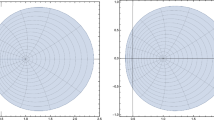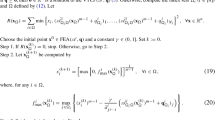Abstract
A classic result of Banach states that the supreme of a multivariate homogenous polynomial is equivalent to that of its associated symmetric multilinear form over unit balls. Using the language of higher-order tensors in finite-dimensional spaces, this means that for a symmetric tensor, its largest singular value is in fact equivalent to the largest magnitude of its eigenvalues. This note strengthens Banach’s results on nonnegative higher-order tensors. It is shown that for a symmetric nonnegative irreducible tensor: (1) any singular value admitting a positive singular vector tuple must be an eigenvalue, where the singular vectors in the tuple must be equal to each other; i.e., they amount to an eigenvector; (2) when the order is odd, any nonnegative singular vector tuple corresponding to the largest singular value must also boil down to a positive eigenvector. These results give the flexibility of directly solving tensor eigenvalue problems via solving tensor singular value problems.
Similar content being viewed by others
References
Banach, S.: Über homogene polynome in (\({L}^2\)). Stud. Math. 7(1), 36–44 (1938)
Bomze, I.M., Palagi, L.: Quartic formulation of standard quadratic optimization problems. J. Glob. Optim. 32(2), 181–205 (2005)
Chang, K.C., Pearson, K., Zhang, T.: Perron–Frobenius theorem for nonnegative tensors. Commun. Math. Sci. 6(2), 507–520 (2008)
Chang, K.C., Pearson, K., Zhang, T.: Some variational principles for Z-eigenvalues of nonnegative tensors. Linear Algebra Appl. 438, 4166–4182 (2013)
Che, H., Chen, H., Wang, Y.: C-eigenvalue inclusion theorems for piezoelectric-type tensors. Appl. Math. Lett. 89, 41–49 (2019)
Chen, B., He, S., Li, Z., Zhang, S.: Maximum block improvement and polynomial optimization. SIAM J. Optim. 22, 87–107 (2012)
Chen, B., He, S., Li, Z., Zhang, S.: On new classes of nonnegative symmetric tensors. SIAM J. Optim. 27(1), 292–318 (2017)
da Silva, A.P., Comon, P., de Almeida, A.L.F.: On the reduction of multivariate quadratic systems to best rank-1 approximation of three-way tensors. Appl. Math. Lett. 62, 9–15 (2016)
De Lathauwer, L., De Moor, B., Vandewalle, J.: On the best rank-1 and rank-(\({R}_1,{R}_2,\ldots,{R}_n\)) approximation of higer-order tensors. SIAM J. Matrix Anal. Appl. 21, 1324–1342 (2000)
Friedland, S.: Best rank one approximation of real symmetric tensors can be chosen symmetric. Front. Math. China 8(1), 19–40 (2013)
Friedland, S., Lim, L.H.: Nuclear norm of higher-order tensors. Math. Comput. 87(311), 1255–1281 (2018)
Hillar, C.J., Lim, L.H.: Most tensor problems are NP-hard. J. ACM 60(6), 45:1–45:39 (2013)
Hu, S., Qi, L., Zhang, G.: Computing the geometric measure of entanglement of multipartite pure states by means of non-negative tensor. Phys. Rev. A 93, 012304 (2016)
Lim, L.H.: Singular values and eigenvalues of tensors: a variational approach. In: 2005 1st IEEE International Workshop on Computational Advances in Multi-Sensor Adaptive Processing, Vol. 1, pp. 129–132 (2005)
Pappas, A., Sarantopoulos, Y., Tonge, A.: Norm attaining polynomials. Bull. Lond. Math. Soc. 39(2), 255–264 (2007)
Qi, L.: Eigenvalues of a real supersymmetric tensor. J. Symb. Comput. 40(6), 1302–1324 (2005)
Qi, L., Luo, Z.: Tensor Analysis: Spectral Theory and Special Tensors, vol. 151. SIAM, Philadelphia (2017)
Wang, Y., Qi, L.: On the successive supersymmetric rank-1 decomposition of higher-order supersymmetric tensors. Numer. Linear Algebra Appl. 14(6), 503–519 (2007)
Yang, Y., Feng, Y., Suykens, J.A.K.: A rank-one tensor updating algorithm for tensor completion. IEEE Signal Process. Lett. 22(10), 1633–1637 (2015)
Yang, Y., Yang, Q.: Further results for Perron–Frobenius theorem for nonnegative tensors. SIAM J. Matrix Anal. Appl. 31(5), 2517–2530 (2010)
Zhang, X., Ling, C., Qi, L.: The best rank-1 approximation of a symmetric tensor and related spherical optimization problems. SIAM J. Matrix Anal. Appl. 33(3), 806–821 (2012)
Acknowledgements
This work was supported by NSFC Grant 11801100.
Author information
Authors and Affiliations
Corresponding author
Additional information
Publisher's Note
Springer Nature remains neutral with regard to jurisdictional claims in published maps and institutional affiliations.
Rights and permissions
About this article
Cite this article
Liang, C., Yang, Y. A note on Banach’s results concerning homogeneous polynomials associated with nonnegative tensors. Optim Lett 15, 419–429 (2021). https://doi.org/10.1007/s11590-020-01602-2
Received:
Accepted:
Published:
Issue Date:
DOI: https://doi.org/10.1007/s11590-020-01602-2




